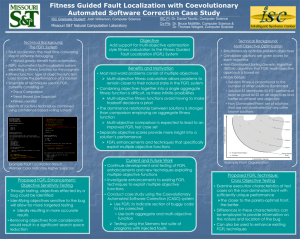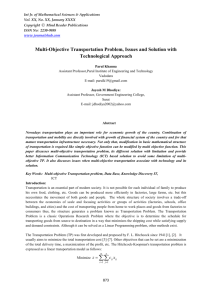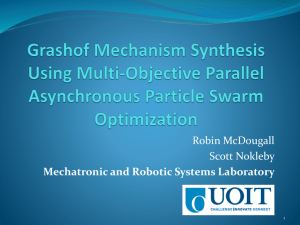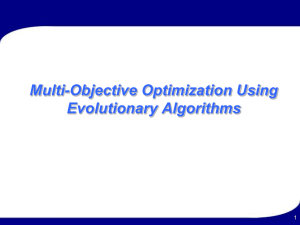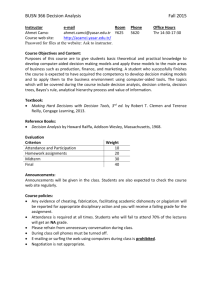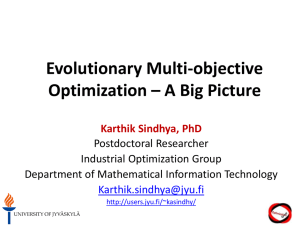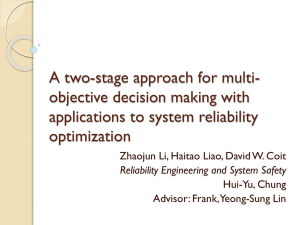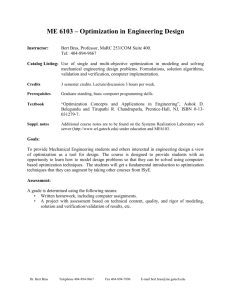Document 12061843
advertisement
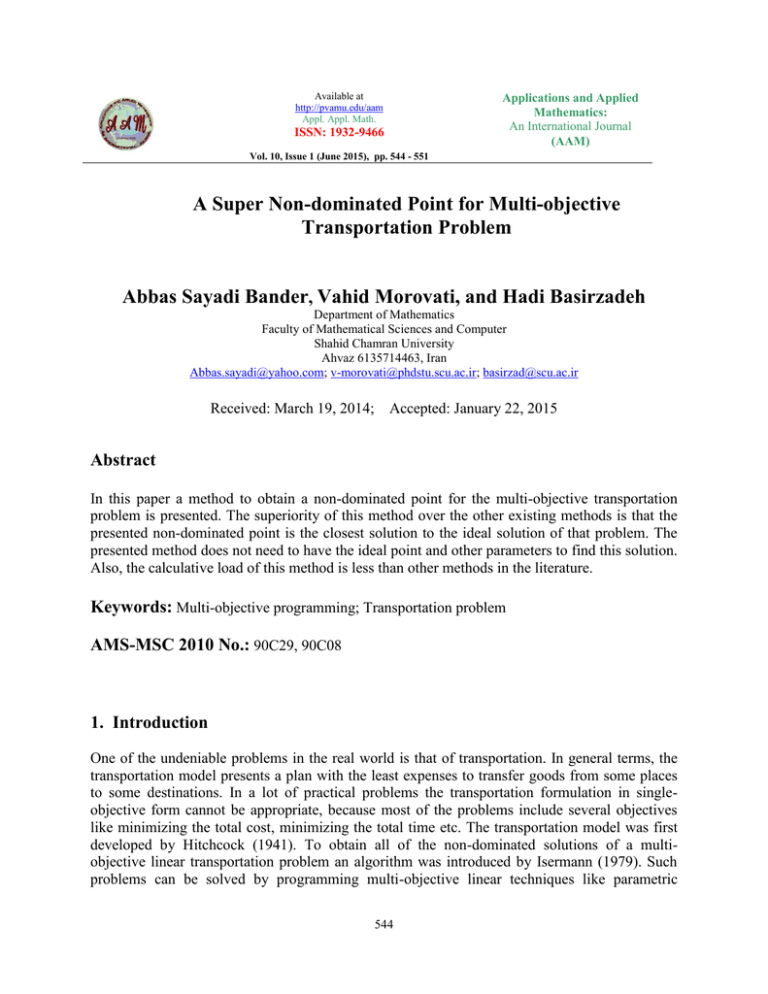
Available at
http://pvamu.edu/aam
Appl. Appl. Math.
Applications and Applied
Mathematics:
An International Journal
(AAM)
ISSN: 1932-9466
Vol. 10, Issue 1 (June 2015), pp. 544 - 551
A Super Non-dominated Point for Multi-objective
Transportation Problem
Abbas Sayadi Bander, Vahid Morovati, and Hadi Basirzadeh
Department of Mathematics
Faculty of Mathematical Sciences and Computer
Shahid Chamran University
Ahvaz 6135714463, Iran
Abbas.sayadi@yahoo.com; v-morovati@phdstu.scu.ac.ir; basirzad@scu.ac.ir
Received: March 19, 2014;
Accepted: January 22, 2015
Abstract
In this paper a method to obtain a non-dominated point for the multi-objective transportation
problem is presented. The superiority of this method over the other existing methods is that the
presented non-dominated point is the closest solution to the ideal solution of that problem. The
presented method does not need to have the ideal point and other parameters to find this solution.
Also, the calculative load of this method is less than other methods in the literature.
Keywords: Multi-objective programming; Transportation problem
AMS-MSC 2010 No.: 90C29, 90C08
1. Introduction
One of the undeniable problems in the real world is that of transportation. In general terms, the
transportation model presents a plan with the least expenses to transfer goods from some places
to some destinations. In a lot of practical problems the transportation formulation in singleobjective form cannot be appropriate, because most of the problems include several objectives
like minimizing the total cost, minimizing the total time etc. The transportation model was first
developed by Hitchcock (1941). To obtain all of the non-dominated solutions of a multiobjective linear transportation problem an algorithm was introduced by Isermann (1979). Such
problems can be solved by programming multi-objective linear techniques like parametric
544
AAM: Intern. J., Vol. 10, Issue 1 (June 2015)
545
method, the adjacent point method and the adjacent basic point method (see Gal (1975) and
Zelenv (1974)). Martnez-Salazar (2014) solved a bi-objective transportation optimization
problem using a heuristic algorithm. In Hongwei (2010) and Kundu (2013). Some methods to
solve multi-objective transportation optimization problem were presented. It is an undeniable
fact that among all of the non-dominated solutions the solution with the least distance from the
ideal solution can be considered decision-maker, and in the second part of this paper a method is
presented to calculate the closest solution to the ideal solution for multi-objective transportation
problems. In the following, the convergence of the method is discussed. In the third part two
examples of the proposed method and the other existing methods are solved, the optimal solution
and the calculative load of the methods are also compared. The results are provided in the final
part.
2. Problem Formulation
The general form of a multi-objective transportation problem is as follows:
( )
∑∑
∑
∑
where the subscript on
and the superscript on
are used to identify the penalty criterion.
Without loss of generality it may be assumed throughout this paper that
for all i,
for all j,
for all (i, j) and ∑
∑
∑
. Notice that the balance condition
∑
is both a necessary and sufficient condition for the existence of a feasible solution of problem
.
Definition 2.1 (Ehrgott (2005)).
is an efficient solution for if there is no other belonged to the feasible region of problem
( )
( ) for some j. If x* is an efficient
such that: ( )
and ( )
solution for then ( ) ( ( )
( )) is a non-dominated point for .
Definition 2.2 (Ehrgott (2005)).
546
Abbas Sayadi Bander et al.
(
) is the ideal point of
( ) for
if
.
Definition 2.3.
is a supper-efficient for
1)
2)
if
is efficient
( ) has the least distance to the ideal point.
If
is a supper efficient then ( ) is called the super non-dominated point. In the following it
is shown that a single-objective linear problem can be solved instead of a multi-objective
problem
and the optimal solution which is obtained from the new problem is the superefficient solution for problem .
Assume
( )
∑
∑
( )
and consider the following problem:
( )
( )
( )
∑
∑
Theorem 2.1.
Every optimal solution for problem
is an efficient solution for problem
.
Proof:
Assume that
is an optimal solution of , but not the efficient solution of , so, there is a
feasible solution (the feasible region of both problems is identical) like that dominates , that
( )
( ) for some j, adding the side of the inequalities
is, ( )
and ( )
( )
there is: ( )
( )
( ), which is in contrast with to optimal for
. So, is an efficient point for .
Definition 2.4.
If
(
) is the ideal solution of problem , the distance of each point of the objective
space from the ideal point (with the norm of L1) is considered as following:
AAM: Intern. J., Vol. 10, Issue 1 (June 2015)
547
∑|
|
Theorem 2.2.
The problem of finding the super-efficient solution (the closest point to the ideal point for the
multi-objective transportation problem) for the problem
is equal to finding the optimal
solution for the problem .
Proof:
If S is the feasible region of problem , the problem of the closest solution to the
ideal solution is considered as following:
∑|
Because
is the ideal point of
, then for each
( )
and for all i,
|
|
)
∑(
Since the vector
|
∑
∑
is specified and obtained, then it can be assumed that
∑
is a fixed value. So, for each
{
there is
∑|
|
∑
}
{
∑
This is the favorite result and the proof is complete.
3. Numerical example
Example 1. Consider the following two-objective transportation problem:
}
548
Abbas Sayadi Bander et al.
∑
∑
∑
∑
∑
∑
∑
( )
Lushu et al. (2000) computed (163,190) (integer solution) or (163.33, 190.83) as the optimal
compromise value of the objective vector (
). Ringuest et al. (1978). Computed (156, 200)
as the most preferred value of the objective vector (
). Bit et al. (1992) obtained (160, 195)
(integer solution) or (160.8591, 193.9260) as the optimal compromise value of the objective
vector (
).
For solving the problem above with the presented method this paper, we have to solve the
following problem:
∑
∑
The optimal solution
∑
∑
∑
∑
∑
x* is obtained:
(
By Theorem 2.1, ( ) ( ( ) ( ) (
problem (1). By Definition 2.2, obtained
(
)
) is a non-dominated point for the
) as the ideal point of the problem (1).
AAM: Intern. J., Vol. 10, Issue 1 (June 2015)
549
The calculated non-dominated points of the problem (1) by various other methods and their
distance from the ideal point are presented in the following table:
Table 1. Result of Analysis for Example 1.
Method
(
∑|
Lusha
)
|
Ringues
Bit
Our method
(163,190)
(156,200)
(160,195)
(176,175)
43
46
45
41
Table 1 shows that the obtained solution by the presented method has the minimum from the
ideal point.
Example 2.
In the following transportation objective problem obtained in Bit (1992), all of the nondominated points and their distances to the ideal point have been collected in a table using a
method known as Figueria.
Solving both problems individually, the ideal solution was obtained (145,179). All of the nondominated points of the problem which obtained by the Figueria method and the distance of
these points to the ideal point are shown in the following table using the d meter.
+ are the non-dominated points which have the
Regarding the Table 2, points of *
least distance to the ideal point. To obtain each of the non-dominated points using the Figueria
method, complicated calculations are required, while using the proposed method solving a
transportation linear programming problem which its target function is the sum of two given
target functions, i.e.
and its feasible region is the feasible region of the two-objective
problem, the solution of
(
) is introduced as the optimized solution which is
included in the points having the least distance to the ideal point. More surprising fact is that if
the distance from the ideal point is being considered with the norm of
the
is the only point
having the least distance from the ideal point.
550
Abbas Sayadi Bander et al.
Table 2. Result of Analysis for Example 2
Point
x1
x2
x3
x4
x5
x6
x7
x8
x9
x10
( )
( )
∑
|
145
215
36
149
211
36
153
207
36
157
203
36
161
199
36
167
195
38
173
191
40
179
187
42
185
183
39
191
179
46
|
4. Conclusion
As in the case of a linear transportation programming problem a non-dominated solution for the
multi-objective transportation problem which has the least distance to the ideal point, can be
obtained. Even through the method of solution may be relatively complicated and has a great
deal of calculative load. The ideal solution itself to problem (2.2) and any other parameters may
not be needed. This represents an advantage.
Acknowledgment
The authors are grateful to the referrers for their helpful comments on some parts of the paper.
REFERENCES
Bit, AK, Biswal MP, Alam, SS. (1992). Fuzzy programming approach to multicriteria decision
making transportation problem, Fuzzy Sets and Systems 50:35-41.
AAM: Intern. J., Vol. 10, Issue 1 (June 2015)
551
Ehrgott, M. (2005). Multicriteria Optimization, 2nd ed, Berlin.
Eusebio, Augusto, Rui Figueria, Jose (2009). Finding non-dominated solutions in objective
integer network flow problems, Comuter & Operation Research 36: 2554-2564.
Gal, T. (1975). Rim multi parametric linear programming. Management Sri. 2: 567-575.
Hongwei, Zhang, Xiaoke, Cui, Shurong, Zou (2010). Multi-Objective Transportation
Optimization based on Fmcica, ICIME, pp. 426-430.
Iserman, HThe (1979). Enumeration of all efficient solutions for a linear multiple-objective
transportation problem. Naval Res. Logist. Quart. 26(1): 123-39.
Kundu, P., Kar, S. and Maiti, M. (2013). Multi-objective multi-item solid transportation problem
in fuzzy environment, Appl. Math. Model. 37, 2028–2038.
Li, Lushu, Lai, KK. (2000). A fuzzy approach to the multiobjective transportation problem.
Computers & Operations Research 27: 43-57.
Martnez-Salazar, I. A., Molina, J., Angel-Bello, F., Gomez, T., and Caballero, R. (2014). Solving
a bi-objective transportation location routing problem by metaheuristic algorithms.
European Journal of Operational Research, 234 (1): 25-36
Yu, P. L. and Zeleny, M. (1974) The techniques of linear multiobjective programming. Revue
Francaise Automatique, Inforrnatique et Recherche Operationelle 3: 5l-71.
Ringuest J-L, Rinks, D.B. (1987). Interactive solutions for the linear multiobjective
transportation problem, European Journal of Operations Research, 32:96-106.
